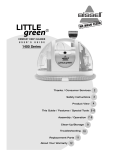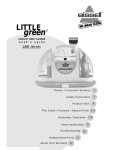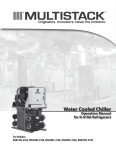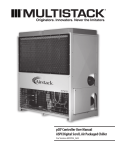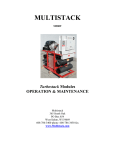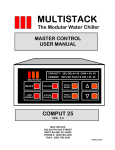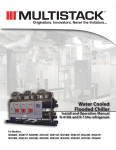Download ASP X Chiller Modules - The Sustainability Initiative
Transcript
ASP X Chiller Modules Operation and Maintenance Manual Table of Contents 1.0 Chiller Identification ...............................................................................................................3 2.0 Theory of Operation ...............................................................................................................3 3.0 Water Treatment ......................................................................................................................3 4.0 Flow Protection .......................................................................................................................4 5.0 System Water Volume............................................................................................................ 4 6.0 Electrical Data ..........................................................................................................................4 7.0 Identification and Explanation of Components ................................................................4 8.0 Factory Setup/Commissioning Information ......................................................................7 9.0 Daily Log Sheet ........................................................................................................................7 10.0 Pressure Readings ................................................................................................................7 11.0 Strainer Cleaning ..................................................................................................................8 12.0 Compressor Oil Level ...........................................................................................................8 13.0 Refrigerant Charge/Evacuation .........................................................................................8 14.0 Filter Driers.............................................................................................................................8 15.0 Condenser Fan Control ........................................................................................................8 16.0 Superheat/Subcooling.........................................................................................................8 17.0 Pressure Relief Valve ............................................................................................................9 18.0 Annual Maintenance ............................................................................................................9 19.0 Compressors ..........................................................................................................................9 20.0 Heat Exchangers .................................................................................................................10 21.0 Optional Low Ambient Package ......................................................................................10 22.0 Optional Pump Modules ...................................................................................................10 23.0 Optional Free-Cool Modules ............................................................................................11 24.0 Optional Glycol Feeder Module .......................................................................................11 25.0 Optional Water Storage Tank Modules ...........................................................................12 26.0 Optional Variable Flow CHW Valves ................................................................................13 27.0 Optional Gear Driven Condenser Fan .............................................................................13 28.0 Troubleshooting Air Cooled Packaged Modules ..........................................................14 2 1.0 Chiller Identification The module information data plate is located inside the electrical box compartment of each module. When ordering service parts or inquiring for technical assistance it is important to provide the model and serial number. 1.1 Water Cooled Model Number ASP15X2H2A0-410a ASP 15 X 2 H 2 A O -410a ASP = Air Stack Packaged 15 = tons (10,15,20,30,60, -tons) X or C = X: Copeland 410a Compressor C : Trane Scroll 2 or 1 = 1: Dual Circuit Evaporator, 1: Single Circuit Evaporator H = 460V (Or: A = 208V L = 230V 2 = Multiple Module Power A = Water Cooled (Or: C = 575V V = special) 1 = Direct Connect Power D = DX unit, R= Heat Pump, F= Free Cool, C=Condenser, L=Fluid Cooler) O = ARI Version 410a = Refrigerant 1.2 Serial Number Identification AJ-06-25 A = Decade built I = 1990’s J= 2000’s J = Year built A= ’01, B= ’02, C=’03…J=’10 06 = June (month built) 01 = Jan. 02 = Feb. 25 = 25th module built 01 = 1st 02 = 2nd A=2010’s 2.0 Theory of Operation The Airstack ASPX chillers provide chilled water to an external load based off of the return water temperature calculated on the module Master Control. When the Entering Chilled Water sensor sends the signal to the Master Control that Cooling is needed, compressors will begin to start and produce Chilled Water. The point at which the Entering Chilled Water temperature calls for compressors to start is determined by the Up - Setpoint, Lo-Setpoint and the Variable Setpoint settings in the System Variables menu of the Master Control. When the ECHW sensor is signaled that Chilled Water temperature has dropped below the set-point, compressors will begin to cycle off. 3.0 Water Treatment Proper water treatment is essential to ensure the peak efficiency and performance of the Chiller. The evaporator side water quality should be kept within the following parameters to prevent any damage to the heat exchangers. The use of hydrochloric, sulfuric, and muriatic acids as well as household bleach can cause stress corrosion to the stainless steel in the heat exchangers. Use of these or any other unapproved chemicals is not covered under the Multistack warranty. Multistack Water Guidelines PH >7 - <9 TDS < 1000 ppm (if glycol used this parameter will be exceeded) Hardness 30 - 500 ppm Alkalinity 30 - 500 ppm (if glycol used this parameter will be exceeded) Chlorides < 200 ppm Sulphates < 200 ppm 3 4.0 Flow Protection Proof of chilled water and condenser water flow is required by the Master Control inputs. Paddle-type or Differential Pressure (DP) switches may be used. Switches are a Multistack option, otherwise they are to field supplied and installed. Chillers purchased with chilled or condenser water pump modules have a DP switch installed across the pump to verify it is running. Multistack recommends a paddle-type switch be installed in the leaving water piping of the chiller, or if using a differential pressure switch install it across the inlet and outlet water connections to the chilled and/or condenser water piping connections. 5.0 System Water Volume Chilled water systems remove the thermal gain from the process of cooling. A properly sized chilled water system will have enough time to properly control, respond to changes in load, and prevent short cycling of the chiller. To ensure the system water volume is adequate, a general rule of thumb is: 7-10 gallons of water per ton or Acceptable Chilled Water Volume = Chilled Water Design GPM X 3 In the event the system components can’t hold the necessary chilled water volume, a properly sized chilled water storage tank should be added. 6.0 Electrical Data Field wiring should be done in accordance with all federal, state and local regulations. Breakers, fuses, wire, and wire size must be sized and installed per the National Electric Code (NEC). Applied voltage to all Multistack chillers must be ± 10% of the unit’s nameplate voltage. The voltage imbalance between phases must not exceed 2%. According to NEMA Standard MG-1-1998, a 2% voltage imbalance will cause a current imbalance of 6 to 10 times the voltage imbalance. It is very important to keep the unbalance between electrical phases to a minimum. There will always be one module in the bank that is the Master Module. This module contains the Master Control Board (far left) as well as the module Slave Board (right of the master). Condenser fan control will either be by on/off pressure control or VFDs. Compressors use contactors as starters and circuit breakers for high and low voltage components. The main power input block is located to the right of the circuit breakers. A module Auto / Off / Manual Mode switch is also available for back up control if the master board would fail. The master module also has the terminal strip inputs for flow switches, start/stop, alarm output, and phase monitor. When shipped the master control panel will also contain the P-Lan communication wire to be field installed and the system Leaving Chilled Water Sensor well to be field installed. 7.0 Identification and Explanation of Components 7.1 Master Module Control Panel There will always be one module in the bank that is the Master Module. This module contains the Master Control Board (far left) as well as the module Slave Board (right of the master). Condenser fan control will either be by on/off pressure control or VFDs. Compressors use contactors as starters and circuit breakers for high and low voltage components. The main power input block is located to the right of the circuit breakers. A module Auto / Off / Manual Mode switch is also available for back up control if the master board would fail. The master module also has the terminal strip inputs for flow switches, start/stop, alarm output, and phase monitor. When shipped the master control panel will also contain the P-Lan communication wire to be field installed and the system Leaving Chilled Water Sensor well to be field installed. 4 7.2 Slave Module Control Panel All modules except the Master Module are referred to as Slave Modules. The only difference between these modules and the master is they do not have the master board or the master input terminals. 7.3 Compressors, Sensors and Switches Standard modules use two scroll compressors piped in tandem. Each compressor has an HP and LP transducer that sends pressures to the module slave board as well as an HP switch with a manual reset button. Compressors have an oil level sight glass that should be at ¼ - 1/8 full during operation. Each module will have its own Leaving Chilled Water Sensor as well as Refrigerant Suction Temperature sensors. In addition the Master Module has and Entering Chilled Water Sensor. A System Leaving Chilled Water Sensor is shipped in the electrical panel of the Master Module and should be field installed 2-10’ after the first module on the take-off side. Heaters on compressors will also be energized whenever power is on the module. Heaters should always be on at least 24 hours before starting the compressors. 7.4 Crossover Pipes, Electrical Feeds Modules ordered with single-point power are shipped with main power wiring to the system power junction box cut to size and wire tied in the module. For rear modules (that do not include the water header pipes and connect back to back with front modules) crossover pipes that connect the front module headers to the rear modules heat exchangers are supplied. The rear module Leaving Chilled Water sensor should plug into the well supplied in the crossover pipe. 5 7.5 Chilled Water Connections Water connections for the evaporator side are 4-8” grooved pipe. The upper header is for Entering Chilled Water to the module. The bottom header is for Leaving Chilled Water from the module. The entering header contains a 30 mesh filter strainer to prevent debris from entering the brazed plate heat exchanger. This filter should be used as a last means of defense. Proper filtration before the module should be installed for easy access to cleaning. 7.6 Expansion Valve, Liquid Line Solenoid, Liquid Receiver Chiller Modules use a mechanical expansion valve for refrigerant control to the evaporator. Superheat should be set to approximately 10-12°F. The Liquid Line Solenoid is used to prevent refrigerant migration into the evaporator during the OFF cycle. A properly sized liquid receiver is used to store excess refrigerant needed in the refrigerant circuit for different ambient temperatures. When the module is designed for Low Ambient Operation to -20°F, a larger receiver than standard is used. 7.7 Nameplate Module nameplate(s) are located on the electrical control box door. Nameplates include phone and address for Multistack, model and serial number (important to supply when calling for service parts or technical support), refrigerant type and charge, and electrical data. 8.0 Factory Setup/Commissioning Information By going to the System Variables Menu and selecting Factory Settings you can access the program type as well as other settings. To change these settings you must enter a password that is available to Authorized Service Technicians by calling Multistack tech support at (608) 366-2400. The Standard program should be used on applications where no glycol is present in the chilled water loop. In this mode the chilled water temp cut out is 34°F. The Low Temp program should be used in applications that have a minimum of 25% glycol in the chilled water loop. Cut out on water temp in this mode is 20°F. The Low Ambient program should be used for applications when the module(s) will be operating below 45°F ambient temperatures, but no glycol is present. If operating below 45°F and glycol is used on the load side the Low Temp program should be used. Refrigerant Type: Choose refrigerant type used in the modules. R410a. Suction Superheat Cut Out: Adjustable from 0-15°F Variable Flow: Select Enable if doing variable flow on the chilled water side or Disable if not. To do variable flow, water control valves must be installed on each module between the water header pipe and heat exchanger. Bypass: Select enable to leave the valve on the lead module open for minimum flow bypass. If no valves are installed on the module keep this variable in the disable mode. For information on basic control setup of the modules see the ASPX Chiller User Manual. 9.0 Daily Log Sheet On the back page of this manual is an information log sheet for the chiller. The log sheet can be used daily, weekly or as desired to record operation characteristics of the chiller. The information recorded on the log sheet can also be very helpful for diagnosing potential problems in the system. 10.0 Pressure Readings The operating suction and discharge pressures in the system are directly related to water flow, condenser temperatures, chilled water set-points, and the cleanliness of the system. Standard operating conditions at 95°F ambient with 45°F leaving chilled water should be 450 psig (125°F saturated) for discharge pressure and 114 psig (38° saturated) suction pressure. All ASPX modules have a high pressure cut out safety device. Each circuit will cut out on HP when the programmed set limit in the master control is met. Standard setting on this is 585 psig. In addition, a backup HP cut out switch is installed on each module. The standard HP cut switch is set at 585 psig for R-410A. Each ASPX module also has a low pressure safety cut out. The LP cut out is controlled by a setting in the program of the module. The LP cut out for modules with R-410A is 50 psig. If circuits are faulting on HP faults, you should first check to see that the fans are operating. If both fans are working check the cleanliness of the condenser coil. A LP fault is an indication of low refrigerant charge in the system. If a circuit is going out on an LP fault check the static pressure of the system while the circuit is in the off mode. If pressures are low check the circuit for possible leaks. The circuit can be pressurized to 15 psig with refrigerant and topped to 160 psig with dry Nitrogen. 7 11.0 Strainer Cleaning All ASPX modules have a 30-mesh filter strainer in the Chilled Water inlet header. The purpose for the filter strainer is to keep debris from entering the heat exchanger. An external “Y” or basket type system strainer should also be installed as a pre-filter to the factory supplied strainers. There is no set time for cleaning the filter strainers. The frequency of this process is dependant on the water quality in the Chilled Water loop. Normally, debris in a water loop is going to take the path of least resistance and build up on the last modules to receive water. If circuits are faulting on Low Suction Temperature, or Low Chilled Water Temperature the Chilled Water inlet filter cartridge should be checked. The strainers are located in the top header on the Chilled Water side. If the strainers are clean, the fault is most likely being caused by a low flow condition--or set-points in the master control that are too low. If these possibilities are eliminated, the Chilled Water heat exchangers may need cleaning. Steps to remove the strainers for cleaning 1. Stop Chilled water pump and shut down chiller. 2. Close inlet and outlet water valves to the chilled water 3. Drain the water/glycol from the top header in the end module so the strainers can be removed. 4. Remove the 4-8” Victaulic end cap on last module. 5. Remove strainers and clean. You may need to make a tool to hook the other strainers for removal. 6. Re-install clean strainers. 7. Open the bottom water isolation valve and fill unit from the bottom up to prevent air from being trapped. 8. Restart Chilled Water pump, bleed any air and start Chiller. 12.0 Compressor Oil Level Compressors used on ASPX modules are oil charged by the compressor manufacturer. The standard tandem Copeland compressors do have an oil equalizer line and oil level sight glass indicator. Oil level should be maintained at 1⁄8 – ¼ full. To ensure no liquid is present in the oil the crankcase heaters should be on 24 hours before starting of the compressors. Factory oil charge volume for each compressor can be found in section 13.0. 13.0 Refrigerant Charge/Evacuation All ASPX modules are factory charged with the recommended refrigerant volume. Prior to charging, each circuit is evacuated to a maximum of 150 microns and held 15 minutes. The proper refrigerant charge for each module can be found on the module data plate. On air-cooled packaged machines, the proper charging procedure is calculated by the weigh-in method. Charging to a full sight glass on air-cooled machines will likely result in over charging because the elbows in the liquid line, as well as the liquid line solenoid valve, still produce some flashing--even with the correct charge. As fans are cycling, the sight glass will also display some bubbling. Model # ASP10X ASP15X ASP20X ASP30X ASP60X Lbs. R410a Lbs. Low Ambient 50 90 60 85 100 100 125 125 220 360 Total Tandem Compressor Oil Charge 114 oz. 220 oz. 220 oz. 252 oz. 426 oz. 14.0 Filter Driers ASPX Chiller modules have a liquid line filter drier installed. When doing a repair to the refrigerant side because of a compressor motor burn, or moisture entering the system, a proper replacement drier should be installed. 15.0 Condenser Fan Control 10-, 15- and 20-ton modules can be ordered with standard pressure control cycling of fans or optional VFD control. ASP30 and ASP60 modules come standard with VFD control. 16.0 Superheat/Subcooling ASPX modules use a mechanical expansion valve. By turning the valve adjustment clockwise superheat is increased. On each module, superheat is set at the factory during the run test. Superheat is set between 10 – 12°F during the test run. Subcooling is necessary in the system to prevent flash gas when the refrigerant enters the expansion valve. ASPX condensers are sized so that subcooling of the liquid refrigerant will take place without a separate subcooler. The general range of subcooling seen is 7- 15°F. 17.0 Pressure Relief Valve Each module has a 650 psig pressure relief valve. The relief valve is installed on the receiver of the module and has a 3/8” thread connection. 18.0 Annual Maintenance 18.1 Electrical Components a. Check all external interlocks. b. Inspect compressor terminals. c. Check compressor crankcase heater operation. d. Tighten all contactors, relay and circuit breaker terminals. e. Check and calibrate all compressor safety controls. f. Check and record voltages and amperages for compressors. g. Check and record amperages for pumps and condenser fans. h. Check and calibrate low ambient/ fan cycling controls. i. Inspect relay contacts for damage or pitting. 18.2 Refrigeration Circuits a. Analyze refrigerant with tube type moisture/acid analyzer. b. Check and record refrigerant subcooling and superheat. c. Check liquid solenoid valves. d. Check expansion valve and sensing bulb connections. 18.3 Chilled Water System a. Clean pump strainers and system strainers. b. Remove header caps and clean the ECHW strainers. c. Check glycol, inhibitor content in system chilled water. d. In severe cases where the chilled side water is contaminated the heat exchangers may need to be backflushed. Multistack has available a cleaning kit do to this task. Please contact Multistack for more information if heat exchanger cleaning is needed. Be sure to use only chemicals compatible with 316L stainless steel and copper. Do not use bleach, or hydrochloric or sulfuric acids. 18.4 Condenser Coils. The condenser side coils should be cleaned periodically of air born debris to maximize efficiency and heat exchange. Coil cleaner compatible with aluminum and copper can be used. Coils can be washed with a garden hose or if careful a pressure washer. Be sure to wash the debris out from the backside of the coils in order to avoid further compacting debris into the coils. 18.5 Cabinet and Related Hardware a. Dry clean electrical panels, remove debris. b. Apply protective coatings or wax if required. 19.0 Compressors With any chiller system there is always the chance of compressor failure. In the event of a failure, proper steps should be taken to determine the cause of the failure. 1. A motor burn due to a fault in the motor insulation is quite rare. Most burnouts are actually caused by a mechanical condition or lubrication problems. In the event of a burnout, proper clean up procedures should be followed. 2. Check all electrical components of the circuit (contactors, fuses, wires, etc.). 3. If necessary, do a system clean up. Nu-Calgon RX-11 Flush, or Sporlan System Cleaner work well. 4. Replace the liquid line filter drier with burnout core. 5. Evacuate the system to a minimum of 500 microns and hold for 20 minutes. 6. Charge the circuit with virgin refrigerant. Charge with liquid into the discharge side. See refrigerant charge on nameplate data of unit. 7. Run the system with a burnout filter core for two-to-three weeks, then replace it with a standard core drier. 9 20.0 Heat Exchangers Multistack uses brazed plate stainless steel heat exchangers on the evaporator side of our modules. These heat exchangers are made of 316L stainless steel and 99.9% pure copper. Condenser side heat exchangers are made from direct expansion copper tube and aluminum fin. Without proper water treatment or due to abuse, the evaporator side heat exchangers can corrode and eventually develop an internal leak. In such an event it would become necessary to replace the heat exchanger. Following are the steps for field replacement of a failed evaporator side heat exchanger. 1. If the refrigerant has not been lost on the failed circuit, you should first do a standard refrigerant recovery. 2. Begin by isolating the module and draining the water/glycol from the loop. 3. Remove the 4- 8” round header pipes that attach to brazed plate heat exchanger (if you have a front module). For rear module(s), remove the crossover pipes from the front module. 4. Cut the refrigerant lines below the elbows and sweat off remaining pipe. 5. Remove old heat exchanger and replace with new one. 6. Fit in copper connections and braze. Purge with Nitrogen while brazing. 7. After brazing, do a leak check and evacuate to a maximum of 500 microns. Charge the circuit according to the name plate specification. If the brazed plate heat exchanger failure has caused water to enter into the refrigerant side, the compressor and condenser side heat exchanger should also be checked for possible contamination. If water has entered into the compressor it is recommended the compressor be replaced as removing all the moisture from the oil is very difficult. Replacement of the condenser side heat exchanger, the expansion valve, and installation of a liquid line filter drier with a water core cartridge is also recommended. Evacuate the circuit to a maximum of 500 microns and let stand for 20 minutes. Charge the circuit, and run two-to-three weeks with the high water core cartridge, and then replace with a standard core. The condenser side heat exchangers on ASPX modules require periodic cleaning of the fins to keep airborne debris from plugging up the fins and causing high pressure conditions. A coil cleaner suitable for copper and aluminum can be used for this. 21.0 Optional Low Ambient Package The standard operating range for ASPX modules is 95°F through 20°F. For operation from 20°F to negative 20°F modules should be ordered with the Low Ambient Package. This includes the flooded head pressure control valve, properly sized liquid receiver tank to handle both summer and winter charge, liquid line check valve, and setting the chiller into the Low Ambient or Low Temperature mode. Note on modules large than 15 tons, two head pressure control valves will be used in parallel. When doing low ambient applications it is also suggested to use VFDs for condenser fan control. 22.0 Optional Pump Modules To provide water flow to the chiller bank, Pump Modules can be provided in various sizes and configurations to connect directly to the mechanical or free cooling modules. The standard pump would be built in the same frame size as the cooling modules and come with a Series 4382 dual arm with 1 primary pump and the 2nd as back up. Pumps can be manually rotated for equal run time or special ordered with auto lead lag capability. 10 23.0 Optional Free-Cool Modules Modules for free cooling can connect directly to mechanical or pump modules to utilize the outside air temperature for cooling the water temperature. Anytime a free-cool module is used a minimum of 25% glycol concentration should be used. The water / glycol in these modules use the fin tube coils for heat exchange. Free-cool modules can work as stand alone or connect via a three-pipe header system to mechanical modules to supplement the cooling. A three-way diverting valve which opens and closes based on ambient temperature will either send water through the free cool module or divert water directly to the mechanical modules. The middle header of the free-cool module should be the inlet connection from the building load. Once water leaves the freecool or if the valve to the free-cool is closed, the water goes to the top header. The top header of the free-cool connects to the first mechanical module so water will then flow to the mechanical modules. Water leaves the mechanical module through the bottom header so the mechanical module bottom header will connect with the free-cool module bottom header. Leaving chilled water can the either exit the chiller through the free-cool module bottom header or that header can be capped and water exits out the opposite ends mechanical modules bottom header. Free-cool module(s) do not communicate directly with mechanical modules. They can be supplied with either fan cycling controls or VFDs that utilize a Carel controller for fan speed control. Please see Free Cool User Manual for more information 24.0 Optional Glycol Feeder Module The Airstack Glycol Feeder Module is one section of a multi-module chiller system. Its purpose is to supply makeup glycol solution to the chilled water loop at the suction side of the pump. Each glycol feeder module is composed of a storage tank and pump assembly, expansion tank, and related control components. NOTE: Do not use the glycol feeder to fill the chilled water loop. The pump inside the glycol feeder is designed to move low volumes of solution at high pressures, not high volumes of glycol solution. Doing so could burn out the pump motor. NOTE: Before supplying power to the pump, make sure the ball valve to the system is closed. 11 Basic Operational Sequence: • With the breakers within the control panel of the glycol feeder module off, apply the correct voltage (+/- 10%) to the module. • Fill the feeder tank with a 25% to 50% mixture of glycol and water. • Set the Control/Mixing Valve to the Mix/Purge position. • Turn on the breakers within the control panel. If there is enough solution, the pump will start, and will purge air from the hoses within the feeder tank assembly. • Turn the Control/Mixing Valve to the Normal position. The reading on the gauge will now start rising. Turn the regulator screw in until the gauge on the regulator reads slightly above the pressure at the suction side of the pumps. • Open the main ball valve to the system. The glycol feeder is now in full operation. It will pump the glycol solution into the system to maintain a constant pressure at the suction side of the pumps. Glycol Feeder Module Control Components: Control/Mixing Valve: The control/mixing valve (on the side of the green cover of the tank) is a two position valve. The first of the two positions is the normal operation position. In this position the pump inside the tank cover will pressurize the internal pressure of the glycol feeder. The second position is the Mix/ Purge operation position where the pump will pull the glycol mixture from the bottom of the tank and pour it back into the tank in a different location mixing the solution. Pressure Gauge: The pressure gauge shows the pressure that the chilled water loop is operating at. It is also showing what the Pressure Regulator is allowing into the chilled water loop. Pressure Regulator: The pressure regulator limits the amount of pressure going into the system from the glycol feeder. When the desired system pressure is reached this regulator closes down. Once the regulator closes down, the internal pressure of the glycol feeder raises until the internal pressure switch shuts off the pump. Pressure Switch: The pressure switch shuts off the pump that is internal to the glycol feeder. Once the pressure regulator closes down and the pressure inside the glycol feeder rises, this component turns the pump off. This component is an internal part to the pump inside the feeder itself. Float Switch: The float switch will shut off the glycol feeders’ internal pump when there is not enough solution in the tank to maintain pressure in the system. This prevents the pump from running without any fluid in it. 25.0 Optional Water Storage Tank Modules As mentioned above under System Water Volume, if low water volume is a problem a Tank module can be supplied with an optional mini glycol feeder (instead of the full module glycol feeder). The tank would be rated at 150 psig and standard volume of 180 gallons and would connect directly to the mechanical, and or, free-cool and pump modules. 12 26.0 Optional Variable Flow CHW Valves To accomplish variable flow on the chilled water side, modules must be special ordered with power actuated butterfly valves. In some configurations this will change the footprint of the modules as valves will need to be installed between the heat exchanger and water header pipe of each module. The valves on each module will open, close, and modulate as compressors cycle on or off. The valves allow flow to go through only modules that are running. Therefore pressure drop increases as modules cycle off (closing valves) and allowing the pump to slow down to maintain constant pressure drop across the chiller. Control of the variable speed pump needs to be taken from the pressure differential between the inlet and outlet of the chilled water at the chiller. Control based off of system pressure will result in erratic temperature control as well as likely faults with operating modules. On the chilled water side a minimum flow needs to be supplied to the chiller. In the factory setup menu of the master control you can select the number of valves to be open all of the time to maintain a minimum flow. For further information on variable flow please see the Multistack Variable Flow Supplement. The Variable Setpoint also works differently when doing variable flow. Since valves are used to isolate each heat exchanger, we do not need to account for the mixing effect of modules that are running with modules in the off mode. On a normal application without water valves, if you have 10 compressors and flow at a true 10°F Delta T with setpoints of 55 Up and 45 Lo and VSP at 50% your no load point would be 50°F. The last module running would be producing water at 50° in and 40° out and mixing with those not ON producing the same temp as system entering (50°). The system LCHW temps would then range between 45-50°F depending on the number of circuits ON and number OFF. With motorized butterfly valves on each module we do not have to take into effect the mixed temperature as those heat exchangers are isolated. Since the CHW pump will be speeding up and down based on a constant chilled water DP we should always be producing the same Delta T through modules as we are with the system temps. So if we kept the VSP at 50% the last module would be on at 50°F entering water temp and producing both module and system leaving temp at 40°F. If we raise the VSP to 80% with the same 55° and 45° setpoints the last module would be on at about 53.5° entering and then produce both module and system leaving temp at 43.5°. So basically when doing variable flow a higher VSP is desired to maintain closer leaving water temps. 27.0 Optional Gear Driven Condenser Fan (low sound) Service recommendations for ASP modules using the Right Angle Gear Drive for condenser fan motor. The gear drive has an oil level sight glass that should be checked regularly. The model # 65 requires .50 gallons of ISO grade 220 synthetic oil (for applications from -20 – 150°F). Change the oil after 500 hours of operation (break-in) then every 6 months or 2500 hours of operation which ever happens first. Since this gear box has only a small amount of oil, proper oil change frequency is the key to longevity. 13 28.0 Troubleshooting Air Cooled Packaged Modules ASPX modules use the Carel PCO3 master control. The user manual for the PCO3 controller is located in section 6 of the submittal package. The user manual details the different status screens and explanations of system or module faults. The following guide is for troubleshooting ASPX modules and the PC03. FAULT SOLUTION No Display on Master Module Check main disconnect for power Check circuit breakers in module Check transformer in modules Check for 24V at J1 on board EX 1,2, Interlock Check appropriate interlock component Check jumpers on TS2 in master module EX 4 Interlock Check for proper rotation, phasing Check PPM device Waiting For Chilled Water Flow Check CHW pump Check flow switch operation Check filter strainers Check TS2 inputs #3 - #5 Low Chilled Water Temp Check LCHW sensor Check setpoints in system variables Check for flow restriction No Demand Check entering ECHW sensor Check setpoints in system variables Check sensor location 100% Demand all the time Check entering CHW sensors Check setpoints in system variables 100% Demand, won’t load Command On at master Control Check sensors Check load limit setting in system variables Excessive Cycling Check VSP setting is system variables Check entering CHW sensor location High Discharge Pressure (HP) Check fan operation Check coil condition Check fan settings in system variables Low Suction Pressure (LP) Check refrigerant charge / leaks Check expansion valve Low Suction Temperature Check suction sensor Check setpoints in system variables Check for flow restriction Communication Error Check settings in system variables Check cables at J11 comm ports Check dip switch settings Circuit Fault Check components in control circuit Check wire crimps in control circuit P Lan Error Check the communication circuit (J11) for loose connections Check for possible airwave interference 14 Daily Chiller Log Sheet Date: Status Suct. Press Ent. Chw Lvg. Chw Upset Loset Head Press Suct. Temp LoChw Temp Fault (if any) Demand Capacity Tdiff Index Comp #1 Comp #2 Comp #3 Comp #4 Comp #5 Comp #6 Comp #7 Comp #8 Comp #9 Comp #10 Comp # 11 Comp #12 System VSP Load Limit System Comments: 15 1064 Maple Avenue Sparta, WI • P 608-366-2400 • F 608-366-2450 www.multistack.com F162ASP O&M 072610
















